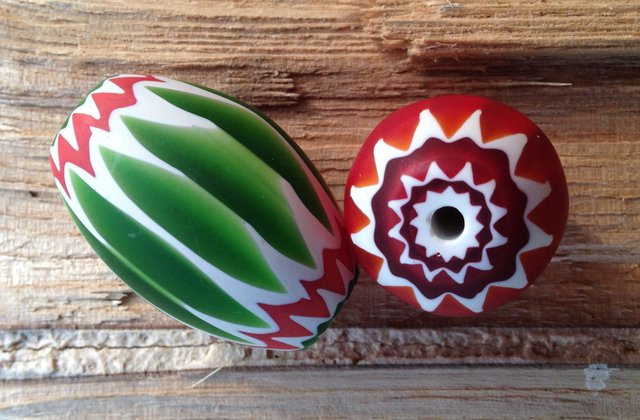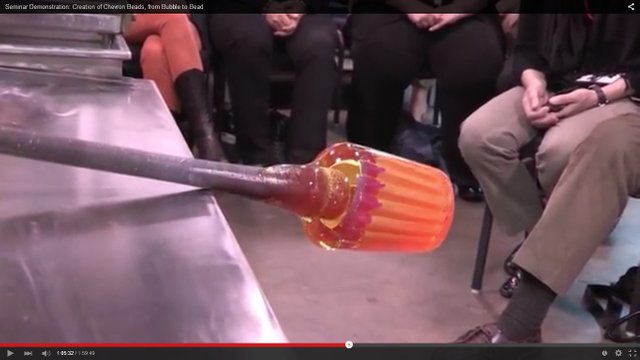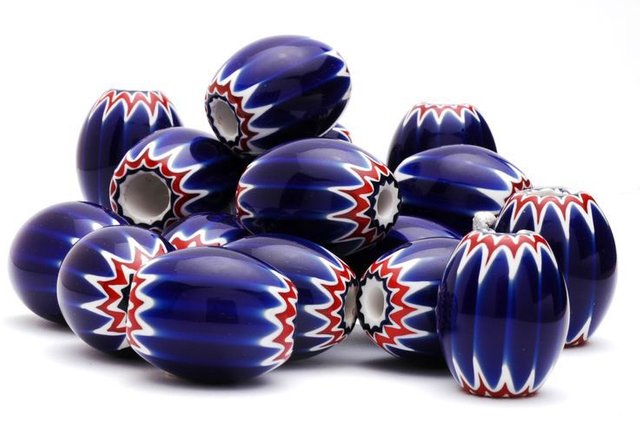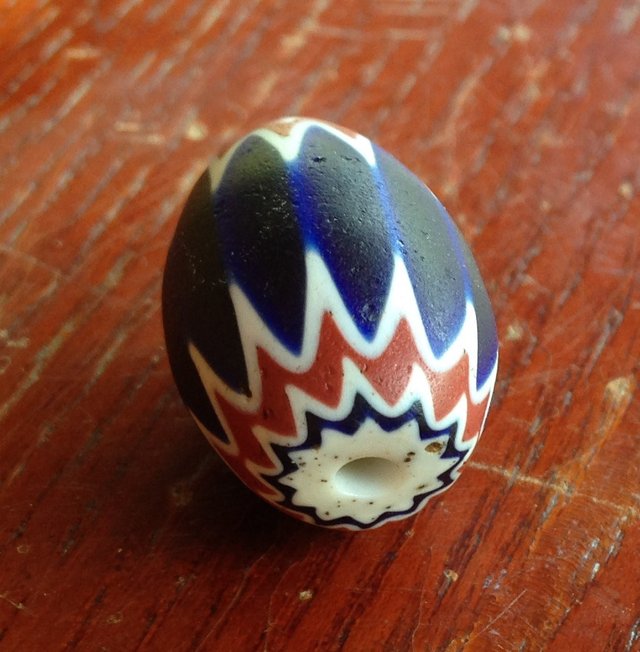The Venetian Chevron: the King of Beads

In mankind’s 40,000 years of beadmaking, one design stands out as the ‘king’: the Venetian Chevron. This highly coveted bead is named for the repeated ‘V’ shape pattern on its ends. The first chevrons appeared in the glassworks of Venice and Murano in the late 1400s. Their beauty and value were quickly appreciated and soon shipments of beads were making their way to all corners of the globe as instruments of trade.
Dutch merchants were among the first to trade with chevrons, bringing them to Africa where buyers would happily trade away ivory, gold, and even slaves for these magnificent glass beads. Around the same time, Christopher Columbus is said to have carried some over to America as trade items. For the next several hundred years, chevrons, as well as many other styles of beads, were very important elements in the trading world.
The Venetians carefully guarded the secrets of how these beads were made but by the 1600s, the Dutch were also making chevrons, possibly aided by the skills brought in by a disgruntled Italian artisan. Since then, it’s estimated that millions have been made.
Despite the chrevron bead’s deceptively simple pattern, the manufacture is actually fairly complex and time consuming. The first step is to take a ‘gather,’ a molten ball of glass, and blow an air bubble into it. This bubble will become the ‘piercing,’ the hole inside the bead. The ball of glass is then drawn through a ceramic star-shaped mold consisting of usually 12 points. A layer of molten glass of a different color is applied to the initial gather and drawn though a slightly larger mold.

Image courtesy Cornell Museum of Glass
This process is repeated with more colors and layers being drawn through successively larger molds. Once all of the layers have been assembled, the glass is heated and stretched into a very long cane, sometimes measuring a hundred feet or more! After a period of cooling, the cane is cut into short segments which will become the individual beads. The bead’s ends are beveled, ground, and polished to reveal the chevron pattern. (You can see a two-hour demonstration of the process by glass artists Ralph Mossman and Mary Mullaney at the Corning Museum of Glass
Red, white, and blue were the most popular export colors but other colors were used as well. The earliest chevrons consisted of seven to ten layers but in the 1800s and 1900s, 4 and 6 layer beads were most common as these were easier to make. A modern artisan, Art Seymour, has made beads with up to 19 layers of glass!

Chevrons are also called ‘rosettas’ or ‘star’ beads. They vary from dime-sized baubles all the way up to half-dollar sized monster beads. Most modern chevrons are coming out of China and India but Venice is still making small numbers of them in exactly the same way they were made 500 years ago. In addition, a few artisans, such as Art Seymour and Luigi Catellan, a descendant of an original Murano glassmaker, are coming out with some inventive and beautiful variations, taking the artform of the chevron far beyond those original red, white, and blues.
Besides being popular collectibles, chevrons are still being used in parts of Africa. The beads are often worn in ceremonies and are sometimes buried with the dead. Many are family heirlooms that have been passed on for hundreds of years from generation to generation.
They are easy to find on sites like Ebay for anywhere from a few dollars apiece for more modern ones to several thousand dollars for a genuine 16th century 7-layered chevron. I bought this nice 19th century six-layered chevron in red, white, and blue. It is truly a wondrous bauble and I can see how people in other lands and times might have coveted objects such as these. They were small portable items of wealth and beauty, easily carried or stored, and easy to trade (or horde!).

I wonder what hands touched my bead? How many eyes have admired its beauty, what stories of joy or woe would it tell? Did it travel from Europe to Africa, traded for all manner of exotics, before moving on to the hands of a native Plains American in exchange for a beaver skin, only to be traded once more to me on Ebay?
It’s a tribute to the designers of the chevron bead that more than 500 years later, it has proven its timelessness and is still being made and admired by many. It’s no wonder, then, that the chevron is called the ‘Aristocrat’, the ‘King of Beads.’
You got a 12.50% upvote from @whalebuilder courtesy of @cavesson. Join @whalebuilder family at our Discord Channel. Don't let your precious stake(SP) go stale...Make it do more so you have to do less. Deligate it to @whalebuilder by clicking on one of the ready to delegate links: 50SP | 100SP | 250SP | 500SP | 1000SP | 5000SP | custom amount.
Congratulations! This post has been upvoted from the communal account, @minnowsupport, by cavesson from the Minnow Support Project. It's a witness project run by aggroed, ausbitbank, teamsteem, theprophet0, someguy123, neoxian, followbtcnews, and netuoso. The goal is to help Steemit grow by supporting Minnows. Please find us at the Peace, Abundance, and Liberty Network (PALnet) Discord Channel. It's a completely public and open space to all members of the Steemit community who voluntarily choose to be there.
If you would like to delegate to the Minnow Support Project you can do so by clicking on the following links: 50SP, 100SP, 250SP, 500SP, 1000SP, 5000SP.
Be sure to leave at least 50SP undelegated on your account.